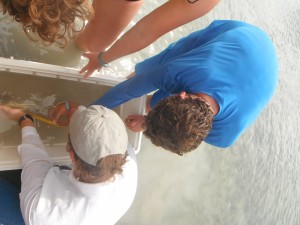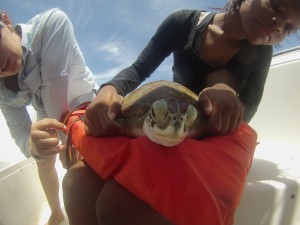Students from the US and Puerto Rico came to the CEI campus for a week of working with researchers in the Shark, Flats, and Turtle Programs. Here is an update from each group.

Flats Team: Campers working the with flats team got a crash course in learning about flats ecology, mangrove ecosystems, and the economic and ecological importance of one target flats species, the bonefish. They gained experience seining, where they caught bonefish and lemon sharks and were able to practice tagging and releasing. Campers also got to try their hand at fly fishing on the flats, and each group caught a few bonefish. The week ended with a presentation on the importance of bonefish conservation in The Bahamas, and the group walked away with knowledge on the importance of flats ecosystems.
Shark Team: The first day of camp, the team went out in the field for the first time; one group went longlining in the creek with baby lemon sharks, and the second group went out on the boat longlining for bigger Caribbean reef sharks.The second day started out with an early bike ride to a 15’ jump called high rock, where all the students jumped and then snorkeled before heading back to breakfast. After breakfast they spent a full day in the field, continuing the research from the previous day. Everyone got to get hands on with the sharks, tagging them, measuring them, and even taking pictures with them. Day 3, the campers spent the morning discussing a research paper on the physiological longlining effects on Caribbean reef sharks. That afternoon they then dissected a juvenile nurse shark before heading out to the marina to snorkel for the rest of the day.

Turtle Team: On Tuesday, the turtle group began catching turtles. It was a very exciting process. After a 30 minute boat ride to Starved Creek, the team searched for sea turtles from the boat. They would then follow the turtle closely on the boat, tiring it out. After the turtle slowed down, one of campers jumped in with snorkel gear. After capture, the team tagged the juvenile green sea turtle so that future turtle researchers will be able to track its growth if they happen to recapture it. The second turtle they caught was much bigger, a sub-adult green sea turtle. This turtle already had its tags. They recorded this turtle’s information including carapace length and width, weight, and a photograph of the shell. The team really enjoyed getting firsthand experience handling and measuring sea turtles.